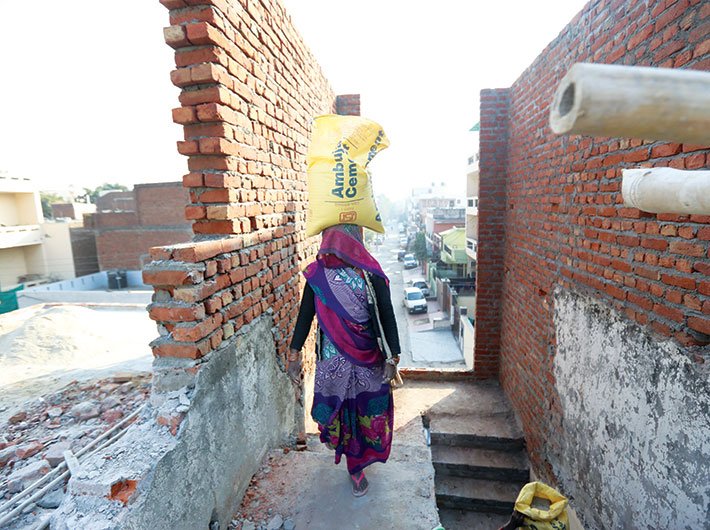The percentage of women on the workforce has declined over the last decade. Experts agree on that, but are hard-pressed to explain this worrying trend
Konika Haldar, 25, and her husband left Malda, in Bengal, five years ago. Today, she works as a domestic help in east Delhi and, as the breadwinner, cannot afford to quit. But she hopes her husband will get a factory job soon. “Then I might not work for a few years, just like my relatives, who stay at home,” she says. “We might then think of having a baby.”
Very different from Haldar’s is the story of Soumaya Tripathi, 29, a management graduate. Till 2014, she kept a corporate job, but under no compulsion to earn, quit. She is now committed to household work. “I couldn’t deal with the competition in the male-dominated industry,” she says.
READ: “The challenge is to ensure that women stay longer in school”
The two young women, with backgrounds that are completely different, exemplify some of the reasons Indian women think of quitting the workforce. For over a decade, experts have sensed a decline in the proportion of women in the workforce, and the perception is backed by field observations.
The National Sample Survey Organisation (NSSO), in one of the world’s largest surveys of employment trends, found the number of women employed falling from 126.49 million (29.4 percent of the workforce) in 2004-05 to 103.6 million (21.9 percent) in 2011-12, down by 7.5 percentage points. These are the latest available NSSO figures, but other studies confirm that the trend continues. The union ministry of labour found women’s participation go down from 25.8 percent in 2013-14 to 23.7 percent in 2015-16. In India, women’s contribution to the GDP was always low – only 17 percent, against the global average of 37 percent, according to the McKinsey Global Institute. Their gradual exit from the workplace darkens this grim tale of unrealised potential.
“Yes, there is a decline,” says Gaurav Bhatia, deputy director (labour bureau), in the union ministry of labour and employment. “Since the population is expanding, the overall labour force, including men and women, has to increase. If the workforce is not increasing, then the participation rate stagnates or shows a fall.” It is worrisome: at one level, the ideals of gender justice are not being met; besides, as an emerging economy, India needs a workforce with a broad spectrum of skills, and this cannot happen without a better gender ratio at the workplace. The success of the centre’s flagship initiatives like Make In India, Digital India, Sagarmala, Bharatmala and Industry 4.0 is also tied to a skilled and versatile workforce.
Bhatia attributes the trend to “multiple factors”; experts, too, are unable to explain it more specifically. Is it related to the ongoing migration of labour from agriculture, the increase in enrolment of women in higher courses and the rise in household incomes? Or is it related to lack of job opportunities for women and other socio-cultural factors? In the absence of focussed surveys, policymakers are unable to draw conclusions. Some factors are worth examining, but they do not lead to clear answers.
High school and higher
Programmes like the Sarva Shiksha Abhiyan seem to be yielding results, and enrolment in secondary schools has improved. Much of this has been in rural areas: the number of rural students has gone up from 188 million in 2004 to 234 million (that’s 28 percent of the rural population) in 2011-12.
“We are witnessing a change,” says Preet Rustogi, a professor at the Institute for Human Development, Delhi, who specialises in gender and labour studies. “Girls above 15 years are going for higher education. They go to nearby urban areas for higher studies and no longer want to work in rural areas.” The number of working women who are graduates or have higher degrees has gone up from five million in 2004 to eight million in 2012, an annual growth of roughly 7.5 percent.
In economies dominated by agriculture, women’s participation in the labour force is high, but as incomes rise, they pull out of farm work and go to school and college. The process ultimately brings them to the labour market, but with better choices and in the organised sector. The real questions, however, are: Has there been a rise in the incomes of families engaged in agriculture? Has the education of rural women resulted in their finding better jobs?
Says Rustogi, “It’s noteworthy that the workforce is definitely becoming more educated. I’d like to believe these educated women from rural areas are looking for jobs in urban areas. But there is a research gap, so we are unable to decipher the extent to which this is happening.” Nor is it clear what job profiles suit educated women from villages.
Rustogi also points out that educated rural women who are unemployed may not have taken jobs that are available to them: they’d probably prefer clerical, secretarial or office jobs, or even shop-floor or sales jobs instead of manual work related to agriculture. Those with low educational levels, however, continue to take up manual and menial jobs.
Working but not working
It’s a common perception that in many rural or semi-urban homes in India, when income brought in by the menfolk improves, the working woman is asked to give up her job. But it’s debatable if this is why women have been quitting the Indian workforce. Nor is it clear if there’s a sizable number of rural and semi-rural households where incomes have risen considerably. For agricultural contribution to the GDP has fallen from 18.3 percent in 2013-14 to 17.4 percent in 2015-16, and the cost of cultivation, mechanisation, and other agricultural inputs has gone up. Land-use patterns, too, have changed – largely from agriculture to non-agriculture.
And though the number of women in agricultural jobs has declined marginally, it’s difficult to say whether this is because they have taken up domestic responsibilities or are engaged in non-paying jobs. Jayati Ghosh, a professor of economics at the Jawaharlal Nehru University, says that in the past decade, there has been an increase in the proportion of women engaged in such unpaid tasks as collecting vegetables, roots, firewood and cattlefeed; sewing and tailoring; and other household activities.
In an article in the Guardian, she says, “...such activities of collection in both rural and urban areas have become more pressing and time-consuming. This indicates a huge failure of public policy. It is because successive governments have not given primacy to such essential as electricity, piped water and easily accessible and affordable cooking fuel that women are still forced to spend long hours in such tasks.”
These women do this work because there’s no one else to do it, and since they are unpaid, the NSS does not recognise them as employed.
Building India
There has been a lot of migration of unskilled women workers from agriculture to construction and manufacturing. “More than four million women work in the construction sector,” says Ratna M Sudarshan, a fellow at the National University of Educational Planning and Administration. “Clearly, the participation of rural women in the construction sector is much higher than that of urban women.”
Similarly, manufacturing has been drawing many women. In rural areas, the percentage of women in factory or small-scale industry jobs went up from 27 percent in 1999-2000 to 38 percent in 2009-10; in urban areas, the corresponding rise was from 28 percent to 40 percent.
Otherwise, the employment pattern for village women has been home-based job works, such as match- and beedi-making, working on looms, making handicrafts, making and packing food and beverages and so on. A few are turning to small-scale entrepreneurship, either by running small stores or jobbing for work that can be done from home.
The uniform brigade
Many women, rural and urban, have moved from the informal sector into the formal sector. According to the NSS, the proportion of rural women in the formal sector has risen from eight percent in 2004-05 to 13 percent in 2011-12, and that of urban women from 36 percent to 43 percent. In absolute numbers, 1.1 million rural women and 2.6 million urban women have been added to the regular workforce in the eight years from 2004 to 2012. They have gone into the IT sector, government, education, healthcare, banking and finance.
But the most visible among them are what Rustagi calls “uniformed women” – those working at malls, metro stations, supermarkets, airports and the like, usually as ushers, sales personnel, attendants, security personnel, cleaners. They are usually employed by contractors who have been hired for providing such personnel, and work on fixed contracts with eligible paid leave. Though there are no benefits like provident fund contributions, they are far better off than in the unorganised sector.
Then why?
Those seem like positive signs. Then why are fewer women taking jobs? And, as Rustagi says, “If men and women look out for similar job profiles, men should be losing out. If that happens, there could be some friction. But this is not visible!” What is implied is that women are not competing with men for jobs.
“Are women opting to be out of the labour force due to their care responsibilities, sociocultural barriers, or capability deficits, which prevent them from getting employed?” asks Ellina Samantroy, an associate fellow at the VV Giri National Labour Institute, Noida. “Or is it the lack of demand for women’s labour that serves as a deterrent?”
In urban areas, experts have found that women’s dropping out from the workforce is related to rising household incomes, husband’s education level, and some sociocultural taboos related to working women. Also, there is no compulsion for women to be breadwinners; in contrast, divorcees and single women find work out of necessity. Studies have found that 32 percent of married women in jobs; the figure for divorced or separated women was 60 percent.
An array of complex and interwoven factors relates to women’s participation in the workforce – and a diagnosis of the problem of fewer women in the workforce will call for a census rather than a survey. The World Economic Forum estimates that raising the spending on education by one percent of the GDP can improve women’s participation by two percentage points. Such spending is as vital as the launching of programmes like Skill India, which should ideally lead to more women taking up jobs. And as more women enter the workforce, more women will aspire to work and improve household incomes and societal restrictions will be breached.
But the challenge is to generate more women-specific jobs, both of the low-paying and high-paying kinds. Economists across the world these days chant the mantra ‘Demography is destiny’. But the full potential of a country like India cannot be realised without the participation of nearly half the population.
archana@governancenow.com
(The story appears in the February 1-15, 2017 issue)

